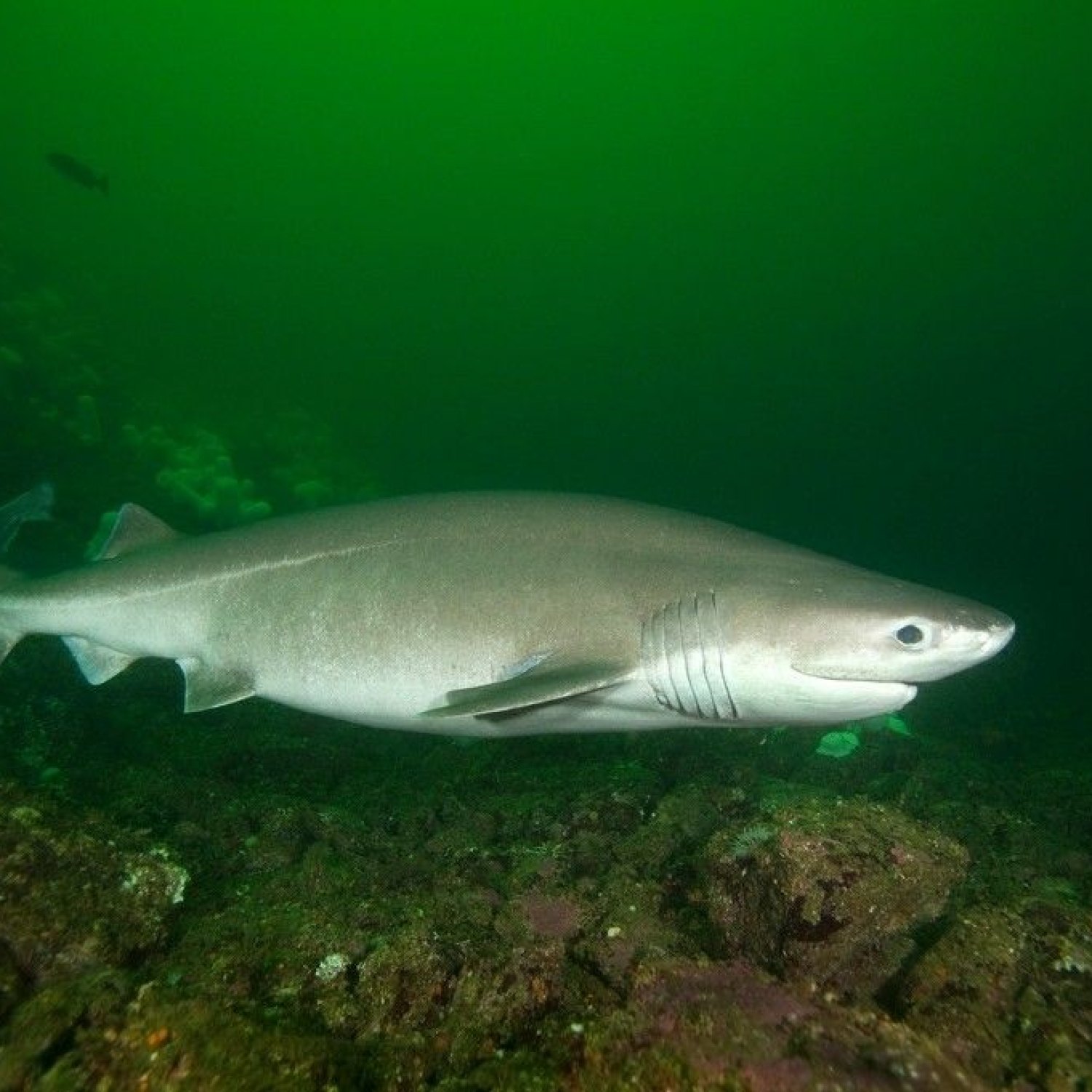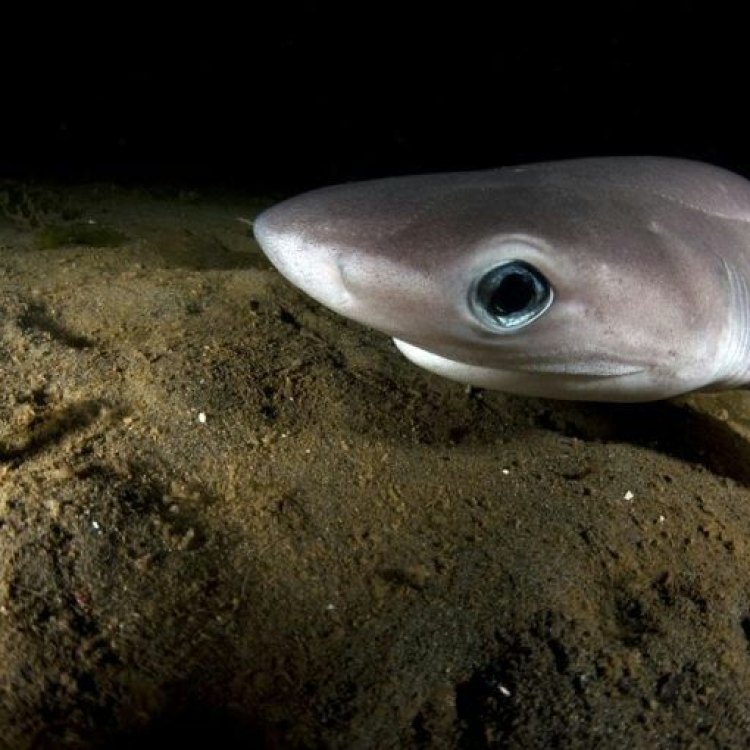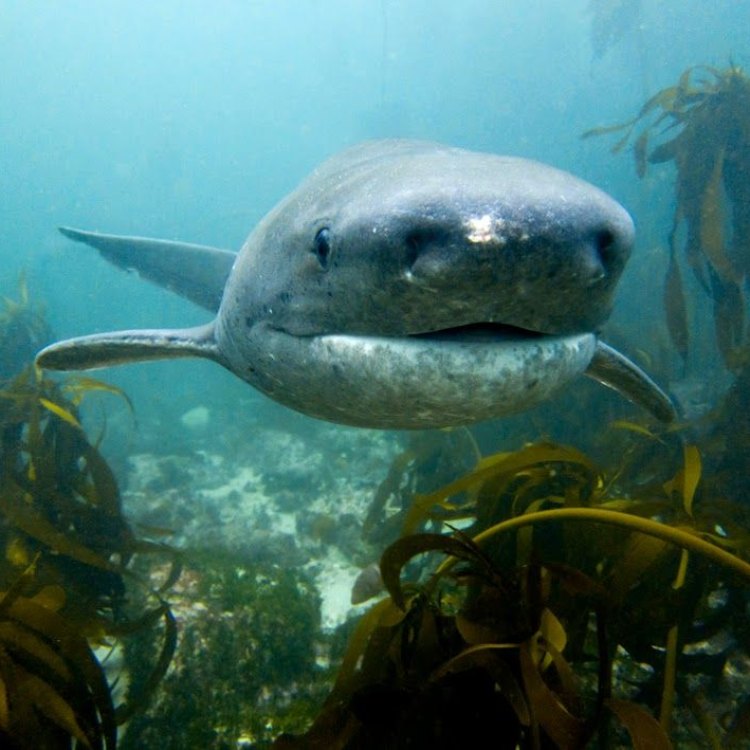
Sixgill Shark
About 15 feet
The Sixgill Shark is a fascinating ocean predator that can grow up to 15 feet long. Found in deep waters, its body is streamlined and cylindrical, making it an efficient swimmer. Belonging to the Hexanchidae family, this shark is a fierce hunter with six rows of teeth. Its unique appearance and habits make it a must-see for any ocean enthusiast. #SixgillShark #Hexanchidae #DeepSeaCreature
Animal Details Summary:
Common Name: Sixgill Shark
Kingdom: Animalia
Habitat: Deep-sea
Sixgill Shark: Exploring the Secrets of the Deep-sea Predator
Nestled in the depths of the ocean lies a creature that has captured the curiosity of scientists and explorers for centuries – the sixgill shark. With its dark brown to black coloration and streamlined, cylindrical body shape, this elusive species prowls the world's deep waters, making it a challenging creature to study.Scientifically known as Hexanchus griseus, the sixgill shark belongs to the animal kingdom, phylum chordata, and class chondrichthyes. It is part of the order Hexanchiformes and the family Hexanchidae Sixgill Shark. The sixgill shark is a carnivore, surviving on a diet of various marine animals, and can be found in different locations worldwide, making it a fascinating species to discover. Let us delve deeper into the world of the sixgill shark and uncover its hidden secrets.
Habitat and Distribution
The sixgill shark is primarily a deep-sea dweller, found in the vast open ocean waters, usually at depths of over 3,000 feet. However, this species can also migrate to shallower depths, ranging from 200 to 2,600 feet, during certain times of the year. They are known to inhabit temperate and tropical waters across the globe, including the Atlantic, Pacific, and Indian Oceans.In terms of distribution, the sixgill shark is a worldwide species, with documented sightings in various countries, including the United States, Japan, South Africa, and Australia. Despite its widespread presence, little is known about the sixgill shark's population size, making it a challenging species to study and understand fully.
Physical Characteristics
One of the most striking features of the sixgill shark is its unique appearance. As the name suggests, this species has six gill slits on each side of its body, distinguishing it from other shark species that typically have five gill slits Seal. The sixgill shark's gills are also positioned further back towards its chest, allowing it to take in oxygen even while resting on the ocean floor.The sixgill shark has a dark brown to black coloration, making it well-adapted to its deep-sea habitat. This coloration also acts as a natural camouflage, helping the shark to blend into its surroundings and remain undetected by predators.
Its body shape is another adaptation to its deep-sea habitat, as the sixgill shark has a streamlined and cylindrical body, allowing it to move efficiently through the water. This body shape also enables the shark to navigate through narrow crevices and caves in search of prey.
In terms of size, the sixgill shark can reach an impressive length of about 15 feet, making it one of the largest known deep-sea sharks. However, there have been reports of specimens measuring up to 20 feet, further highlighting the mystery and intrigue surrounding this elusive predator.
Feeding Behavior
The sixgill shark is a carnivore, meaning it survives on a diet of various marine animals. Its sharp, serrated teeth are well-suited for hunting and feeding, as they can easily tear through the tough skin of its prey. The sixgill shark's diet can consist of a range of marine animals, including fish, squid, crustaceans, and even other sharks.One of the most fascinating aspects of the sixgill shark's feeding behavior is its ability to consume prey of almost any size. Its elastic jaws allow it to expand its mouth and swallow large prey whole, while its serrated teeth help to keep the prey from escaping. This feeding behavior is essential for the survival of the sixgill shark, as food sources can be scarce in the deep-sea environment.
Exploring the Deep-sea with Technology
With limited knowledge about the deep-sea environment and the species that inhabit it, studying the sixgill shark has been a challenging task for scientists. However, with advancements in technology, researchers have been able to explore the depths of the ocean and gain a better understanding of this mysterious creature.One example is the use of deep-sea submersibles, such as the Ocean Xplorer, to capture high-resolution video footage and images of the sixgill shark in its natural habitat. This technology has enabled scientists to observe the shark's behavior, feeding habits, and interactions with other species, providing valuable insights into its ecology.
Another technological advancement that has aided in the study of the sixgill shark is the use of acoustic telemetry. This involves attaching acoustic tags to the shark's body, which can be detected by underwater receivers, allowing scientists to track the shark's movements and understand its behavior better.
The Importance of Conservation
The sixgill shark's elusive nature, combined with limited knowledge about its population size and distribution, has made it a challenging species to study and subsequently protect. However, with increasing threats to the world's ocean ecosystems, it is crucial to understand and conserve the sixgill shark and its habitat.One of the main threats facing the sixgill shark is overfishing. As a large, deep-sea species, the sixgill shark is susceptible to becoming bycatch in commercial longline fishing operations. This has resulted in a decline in the species' numbers in certain parts of the world, highlighting the urgent need for conservation efforts.
Protecting the sixgill shark's habitat is also crucial, as environmental changes can severely impact the shark's survival. The ocean's warming temperatures, caused by climate change, can disrupt the shark's food sources and affect its reproduction and growth. Conserving the deep-sea habitat is essential to maintaining a healthy balance in the ocean's delicate ecosystem.
The Enigma of the Deep-sea Predator
In conclusion, the sixgill shark's mysterious nature, combined with its unique physical characteristics and deep-sea dwelling habitat, has captured the interest of scientists and the public alike. Despite its widespread distribution, the limited knowledge about this elusive species has made it a challenging creature to study and understand fully.With advancements in technology and increasing conservation efforts, there is still much to discover about the sixgill shark. As we continue to explore the depths of the ocean and unravel the secrets of this deep-sea predator, it is essential to understand the importance of protecting the sixgill shark and its habitat for the benefit of our oceans and future generations.

Sixgill Shark
Animal Details Sixgill Shark - Scientific Name: Hexanchus griseus
- Category: Animals S
- Scientific Name: Hexanchus griseus
- Common Name: Sixgill Shark
- Kingdom: Animalia
- Phylum: Chordata
- Class: Chondrichthyes
- Order: Hexanchiformes
- Family: Hexanchidae
- Habitat: Deep-sea
- Feeding Method: Carnivorous
- Geographical Distribution: Worldwide
- Country of Origin: Various
- Location: Deep ocean waters
- Animal Coloration: Dark brown to black
- Body Shape: Streamlined and cylindrical
- Length: About 15 feet

Sixgill Shark
- Adult Size: Up to 20 feet
- Average Lifespan: Unknown
- Reproduction: Ovoviviparous
- Reproductive Behavior: Mating occurs in deep waters
- Sound or Call: Unknown
- Migration Pattern: Unknown
- Social Groups: Solitary
- Behavior: Nocturnal and slow-moving
- Threats: Fishing, habitat degradation, and climate change
- Conservation Status: Data Deficient
- Impact on Ecosystem: Apex predator
- Human Use: Fishing and scientific research
- Distinctive Features: Large, six gill slits on each side of the head
- Interesting Facts: 1. Sixgill Sharks are one of the oldest shark species, dating back over 200 million years. 2. They are named after the six gill slits on each side of their head. 3. Sixgill Sharks have a broad diet, feeding on a variety of fish and marine mammals. 4. They are deep-sea dwellers, typically found at depths of 2,000 to 3,000 feet. 5. Despite their large size, Sixgill Sharks are slow swimmers and have a gentle disposition. 6. The reproductive behavior of Sixgill Sharks is not well-studied and remains largely unknown.
- Predator: Apex predator in its ecosystem

Hexanchus griseus
The Enigmatic Sixgill Shark - A Giant in the Depths
The ocean is a vast and mysterious world, filled with a myriad of creatures that continue to fascinate and intrigue us. Among these creatures, the Sixgill Shark stands out as a truly unique and enigmatic species. With its large size, distinctive features, and elusive behavior, this deep-sea creature has captured the imagination of scientists and ocean enthusiasts alike.The Sixgill Shark, also known as the Hexanchus griseus, is a primitive species that has remained relatively unchanged for over 200 million years PeaceOfAnimals.Com. It belongs to the order Hexanchiformes, which also includes the more commonly known cow and frilled sharks. It is found in temperate and tropical waters around the world, with particularly high concentrations in the Atlantic, Pacific, and Indian Oceans. Let's delve deeper into the characteristics and behavior of this fascinating species.
Size and Lifespan
The Sixgill Shark is a large species, with adults reaching up to 20 feet in length. This makes it one of the largest shark species in the world, surpassed only by the Whale Shark, Basking Shark, and Great White Shark. However, its average lifespan remains unknown due to limited research on this species.Reproduction and Behavior
Sixgill Sharks are ovoviviparous, meaning they give birth to live young. However, their reproductive behavior is still not well-studied and remains largely unknown. Mating is believed to occur in the deep waters, where these sharks typically reside Summer Tanager. Female Sixgill Sharks are known to produce large litters, with one litter observed to contain 22 pups. They have a relatively slow growth rate, with females reaching sexual maturity at around 18-35 years, and males at 11-18 years.In terms of behavior, Sixgill Sharks are known to be solitary creatures, rarely seen in groups. They are nocturnal and slow-moving, spending most of their time resting on the sea floor during the day before venturing out to hunt at night. Due to their elusive behavior and deep-sea dwelling, studying these sharks in their natural habitat has proven to be a challenging task.
Distinctive Features
The Sixgill Shark is easily distinguishable from other shark species by its distinctive features. As the name suggests, it has six gill slits on each side of its head, instead of the typical five slits found in most shark species. This unique characteristic gives the species its scientific name, Hexanchus, which means "six gills" in Latin. The shark's eyes are on the sides of its head, giving it a wide field of vision to navigate in its dark deep-sea environment. It also has a broad, flattened head and a long, cylindrical body, with a small dorsal fin situated towards the posterior end of its body.Feeding Habits
Sixgill Sharks are apex predators in their ecosystem and have a diverse diet, feeding on a variety of marine organisms. Their prey includes squid, shrimp, crab, lobsters, fish, and even marine mammals such as seals and dolphins. They are opportunistic hunters, and their slow movement and large jaws make it easy for them to catch and consume their prey.Habitat and Human Interaction
Sixgill Sharks are deep-sea dwellers, typically found in the depths of 2,000 to 3,000 feet. However, they have been observed to swim to shallower depths at night to feed. Due to their elusive nature and deep-sea habitat, they are not encountered by humans often. However, they have been caught as bycatch in fishing nets, and their slow reproductive rate makes them vulnerable to overfishing. Habitat degradation and climate change are also threats to this species, as they depend on healthy ocean ecosystems for survival. As a result, their conservation status is listed as Data Deficient by the IUCN Red List.Despite human interference, Sixgill Sharks play a crucial role in the ocean's ecosystem as apex predators. They maintain balance and regulate the population of their prey, ensuring a healthy ocean habitat. They are also used in scientific research to gain a better understanding of their behavior, and their unique features have made them a subject of fascination for many marine biologists.
Interesting Facts
1. Sixgill Sharks are one of the oldest shark species, dating back over 200 million years.2. They are named after the six gill slits on each side of their head.
3. Sixgill Sharks have a broad diet, feeding on a variety of fish and marine mammals.
4. They are deep-sea dwellers, typically found at depths of 2,000 to 3,000 feet.
5. Despite their large size, Sixgill Sharks are slow swimmers and have a gentle disposition.
6. The reproductive behavior of Sixgill Sharks is not well-studied and remains largely unknown.
The Wonders of the Deep
In conclusion, the Sixgill Shark is a truly fascinating species that continues to amaze and mystify us. From its ancient origins to its large size and distinctive features, it is a true wonder of the deep. While much is still unknown about their behavior and reproductive habits, it is crucial to protect and conserve this species to maintain the delicate balance of our oceans. By learning more about these elusive creatures, we can gain a greater understanding of our vast and mysterious ocean, and the creatures that call it home.

Sixgill Shark: Exploring the Secrets of the Deep-sea Predator
Disclaimer: The content provided is for informational purposes only. We cannot guarantee the accuracy of the information on this page 100%. All information provided here may change without prior notice.












